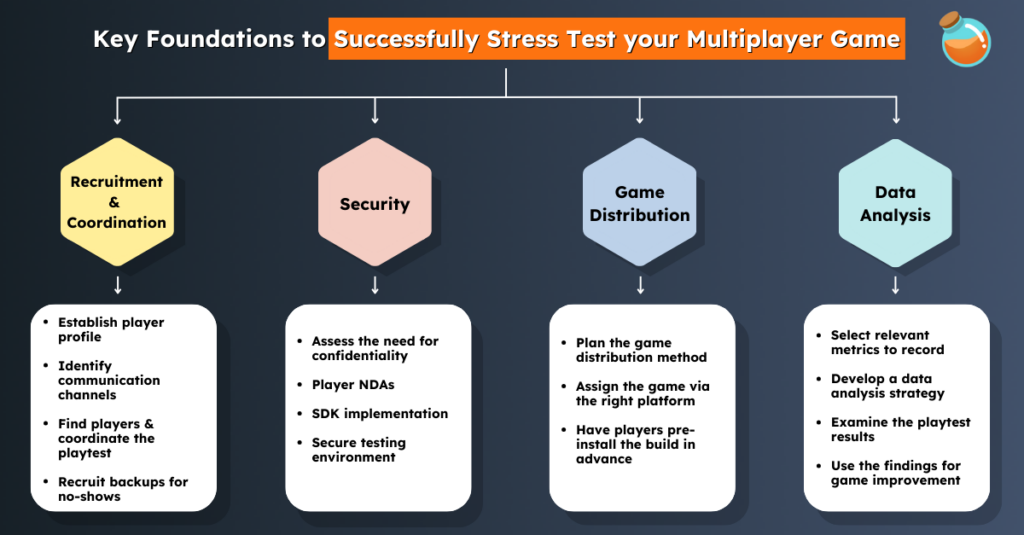What makes a stress test a non-negotiable step in your game development process?
When picturing the ideal game launch, studios often prioritize stunning visuals, gripping narratives, and intuitive in-game mechanics.
While these Game User Research (GUR) factors are vital components of a memorable gaming experience, there is often an overlooked element – the assurance of a smooth and bug-free performance.
Recent findings reveal that gamers in the UK and USA have identified buggy releases and performance issues as the leading setbacks in their gaming experiences, with a significant 60% considering these to be major negative impacts.
This stark statistic sends a clear message to the industry: optimal game performance is not just a goal, it’s an expectation from your players.
Therefore, the importance of stress testing becomes undeniably clear.
The following article will highlight key facets for you to consider before conducting your research study.
Over 60% of gamers cite buggy releases and performance issues as the biggest detriments to their gaming experience
Importance of Stress Testing in Games
A stress test (also known as a load test) evaluates a game’s infrastructure, from server stability to load balancing, under extreme conditions.
The goal?
To identify your game’s bottlenecks and weaknesses before they impact real-world users.
This proactive approach is designed to simulate peak performance scenarios, ensuring that when the game goes live, it delivers the high-quality experience players demand without interruption.
For that reason, stress testing is pivotal in your game development process, assuring that your game can manage the influx of players and maintain performance at critical launch times.
However, what are the key preparations you should consider prior to executing your playtest?
4 Key Stress Test Preparations
We at Antidote have organized and led numerous stress tests.
Based on our experience, we’ve identified four critical steps you should consider to maximize the success of your playtest.

1. Player Recruitment & Coordination
Stage 1 - Recruitment
Unlike other research methods, a stress test requires a vast number of participants playtesting at the same time to accurately simulate real-world gameplay scenarios.
This often means you’ll need to find, vet and recruit a large group of playtesters (typically from a few hundred to even thousands) to create realistic conditions for concurrent gameplay.
That’s a lot of players!
Thus the initial step would be determining where and how to find the required number of participants. If you already have a community large enough and ready to participate simultaneously, that’s fantastic!
If not, you may need to explore external strategies, like partnering with a dedicated GUR platform with an existing player base or launching external recruitment campaigns.
Moreover, you’ll need to align the following participants with your study’s specific criteria. Defining your requirements is a key step before designing surveys and launching recruitment campaigns, as it reassures that every player can meet your project’s demands.
Some important criteria that you should consider during your search can include:
- Location
- Device specifications
- Minimum internet speed
These factors will influence how challenging it is to recruit the right players and achieve your desired attendance numbers.
For maximum efficiency, you should try to match your audience with your game server’s location to enhance performance and minimize latency. If your project spans across multiple countries, planning for time zone differences should be accounted for to ensure everyone can participate at the same time.
Remember, the goal of a stress test is to examine your game’s technical aspects, not to measure the overall user experience. Hence, criteria such as age or gender might not be relevant since they don’t impact the study’s overall goal.
If your aim is to test the ‘experience’ side of your game, conducting a large-scale multiplayer playtest could be a more suitable option for you!
With that in mind, that’s quite a bit to take in, so you might be wondering what’s the best way to prepare.
The prospect of recruiting on this scale might seem overwhelming at first. However, a well-structured plan and execution can make managing large-scale recruitment less intimidating.
For example, consider the following questions when developing a recruitment strategy:
- Where will I find the right participants for my stress test?
- What player criteria do I need for my study?
- Am I using my own player community or seeking an external one?
- How shall I design my surveys to screen the potential playtesters?
- What incentives are most effective in attracting the right players for my test?
- How will I distribute the rewards?
- What will the onboarding process look like?
Bonus Point
Before the playtest begins, it’s paramount to set the right expectations with your players.
Stress tests are designed to evaluate the technical performance of your game, including its ability to handle high traffic without compromising stability. It’s important to inform your participants that they might encounter issues like lags, crashes, or disconnections.
This transparency will help to prevent any disappointment or frustration among players who may otherwise expect a typical gameplay experience focusing on UX elements like story, graphics, and so on.
By doing so, you will protect your game from any negative perceptions or misunderstandings that could arise during the study.
Stage 2 - Coordination
The player recruitment is only the first step of the journey.
Think about it, when was the last time you organized a live event with hundreds or even thousands of attendees? Also, how did you ensure smooth communication and account for the no-shows?
These considerations are why preparing a coordination plan and having player backups are crucial for a successful stress test. Without clear communication, you risk delays from participants missing the test due to forgetfulness or confusion about the process.
And let’s face it, in an ideal world everyone turns up, but that’s rarely the case.
Anticipating no-shows is critical, as they can delay your study by reducing the amount of players available for feedback.
Being prepared can save you stress and unforeseen costs.
Some questions that you might ask yourself regarding this stage:
- What platforms will I use to communicate with players? (e.g., Email and Discord)
- When should I send out reminders?
- Which platform will host the playtest?
- Will I plan to record some sessions for future analysis, and if so, how?
- How will players access the game?
- What’s the plan for moderating the playtest?
- How many backup participants should I invite?
If you want to save time and simplify the whole recruitment process, you can utilize Antidote’s established and growing player community.
This way you can bypass the complexities of finding the right players and worrying about scheduling.
Bonus Point
Clear communication should take center stage during the stress test.
It’s essential to implement a live moderation strategy to swiftly address player questions or resolve any issues.
As you test the limits of your server, participants are likely to run into technical errors during the playtest. Although encountering these is part of the stress test’s objectives and can provide critical insights, it’s still necessary to assist players quickly to avoid delays and frustration.
Also, considering the volume of participants, choosing the right communication channel becomes even more important for seamless execution.
For example, while email may serve well for communication before and after the sessions, it might not be the most efficient method during the test due to the absence of a unified space for all participants.
Imagine trying to deal with hundreds of separate emails quickly and at the same time!
From our experience, using a platform like Discord can offer several advantages:
- Instant communication with players
- A dedicated server where all participants can gather
- A stronger sense of community
- Familiarity with many players
While the choice of platform is ultimately up to you, it’s important to pick one that facilitates easy interaction and centralizes participants for announcements, as well as feedback sharing.
Successful stress testing relies on effective player recruitment & coordination. This involves developing a strategy to identify the right participants and coordinating the study
2. Assessing Security Needs
Stress tests, by design, involve a large number of players simultaneously interacting with the game’s infrastructure.
Keeping this in mind, having more participants increases the likelihood of content leaks following the sessions.
Hence you should consider evaluating the security measures for your game based on the development phase of your project and the release date.
Typically, stress test can apply to:
- Games that have already been released.
- Unreleased games still in development
For stress tests conducted on games already in the public domain, perhaps testing a new server or upcoming game update, the fear of content leaks might not be as high.
In these circumstances, the game’s content is already known to the public and the focus is usually more on technical performance rather than content confidentiality. In some cases, the game might even benefit from extra exposure, by creating hype in anticipation of the final release.
However, the scenario can shift drastically when dealing with pre-launch or highly-confidential titles.
For sensitive and unreleased projects which are not ready to start an awareness marketing campaign, ensuring the confidentiality of game feedback, content, mechanics, and narrative can be a priority for some studios.
A breach could not only spoil the game for potential players but also give competitors insight into your game’s mechanics and unique selling points. Therefore, establishing a security plan is essential if confidentiality is a key factor in your remote playtest.
Consider implementing the following security measures:
- Non-Disclosure Agreements (NDAs): Require all test participants to sign NDAs, legally binding them to confidentiality regarding the game’s details.
- Software Development Kits (SDKs): Utilize SDKs to add a layer of security, allowing remote control over the game’s launch and assigning unique identifiers to each participant showing as watermarking codes.
- Creating a Secure Testing Environment: For remote sessions, plan how the participants will access your game without keeping it after the playtest.
- Educating Participants: Make sure players understand the test’s rules and confidentiality requirements, reinforcing the importance of security before and after the session.
If confidentiality is a major concern for your research study, careful planning of security measures ensures your stress test delivers crucial player feedback while safeguarding your game’s content and integrity.
The level of security you require will dictate your playtesting approach. Utilize measures like NDAs and SDKs to maximize your study’s security and confidentiality
3. Game Distribution
When organizing a stress test, instead of moderating a small group of people like in other research methods, you’re tasked with securely and efficiently distributing game copies to a considerable number of participants.
Therefore, choosing the right distribution method for your game is important for fortifying the security of your study and ensuring a seamless gameplay session.
Depending on the platform of your game’s build, you can employ:
- Test Flight for the iOS-based games
- Google Play Console for the Android-based games
- Steam Keys for PC-based games
All these methods allow you to directly invite testers and limit access to authorized-only users specifically for your research study.
For enhanced support and streamlined distribution, consider working with a specialized GUR platform. This approach will allow you to internally distribute the game via the dedicated platform, offering you greater flexibility and organization before the playtesting session.
Bonus Point
A helpful tip for even easier operation, having participants install your build before the playtest day can be a game-changer.
This overlooked approach is beneficial for several reasons:
- Resolve any potential technical issues early on before the start of the test
- Account for variable internet speeds and provide more time for the installation, ensuring everyone is ready to go when the test starts
- Encouraging pre-installation minimizes the risk of delays caused by participants forgetting to download the game or encountering last-minute issues.
Effective game distribution paired with build pre-installation helps to streamline your stress test planning.
This approach facilitates a more straightforward testing process, while also better positioning you to collect valuable feedback from the players without significant delays or additional costs.
Choosing the right game distribution channel and ensuring participants install the build before the playtest day can prevent significant delays, reducing stress and saving time
4. Strategic Analysis
Selecting the right metrics to monitor during your playtest is crucial for understanding your game’s technical performance and pinpointing areas for improvement.
Since every study has its unique research objectives, choosing the right metrics to track can directly impact the success of your stress test.
A well-thought-out strategy ensures your study extracts the maximum value, while minimizing the waste of time and resources.
Here are a few examples of metrics to consider:
- Server stability: Ensure your game remains accessible under heavy load
- Load balancing (server scaling): Automatically create new server instances when the current one reaches capacity, distributing player load to maintain stability
- Load times: Gauge the responsiveness of your game during peak usage
- Error rates: Identify and fix bugs that could disrupt the gaming experience
While these particular metrics are a good place to start, it’s important to tailor them to your requirements.
Different metrics suit various stress test objectives, be it pre-launch checks, post-server upgrade evaluations, or assessments after adding new features.
Collaborating with your stakeholders and your development team will help to clarify your objectives, setting the stage for a successful data collection process.
Data Analysis
Collecting data is just the first piece of the puzzle.
The challenge lies in translating this vast amount of information into actionable insights that can be presented directly to your development team.
If you’re planning to dive into your research findings, be ready for the heavy lifting involved in sorting, visualizing, and breaking down the raw data.
What are the good metrics to analyze after a stress test?
- Performance metrics: Inspecting results for set metrics, such as error rates and response times
- Concurrency issues: Identify any issues that happen during peak server capacity
- Scalability thresholds: Determine the maximum number of players the game can support before performance degrades
- Server infrastructure: Analyze server performance like CPU and network bandwidth usage under a high player load
It’s crucial to have a clear strategy and tools in place from the start. This preparation ensures you can effectively turn all that collected data into valuable feedback and improve the technical aspects of your game.
For example, let’s say you observed during the playtest that the servers are struggling to handle peak player numbers, leading to lags and disconnections.
By pinpointing specific times or gameplay features that cause the highest load, you can improve the backend infrastructure so it’s optimized for similar scenarios in the future.
For studios looking for an in-depth analysis without dedicating extensive time, opting for Antidote’s top-line report can be an invaluable option.
Our experienced, in-house UX team can handle the complexities of going through the raw data and transforming it into a report that can be presented directly to your stakeholders.
This will allow your team to concentrate on refining game mechanics with confidence, equipped with actionable feedback derived from real player interactions.
To extract the maximum value from your stress test, strategically select what metrics you are going to track and how you are going to analyze the results after the playtest
Summary
A stress test is more than just a technical checkpoint, it’s an opportunity to deeply understand your game’s performance and capabilities under extreme conditions.
This article outlined four key areas game studios should consider before executing a stress test:
- Player Recruitment & Coordination
- Assessing Security Needs
- Game Distribution
- Strategic Analysis
The insights shared here draw from Antidote’s extensive background in conducting stress tests across a range of game genres and platforms.
Given the nature of this research method, which includes conducting a large-scale playtest with hundreds of participants simultaneously, prior planning is essential for your project’s success.
If you are seeking a trusted partner for your upcoming stress test, Antidote is here to help. We can assist with coordinating your entire study, from player recruitment to playtest execution and generating a top-line report.
You can contact us for any questions and to see how we can help to streamline your research study.



